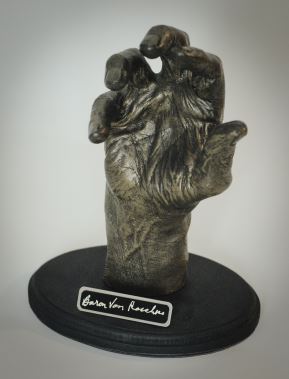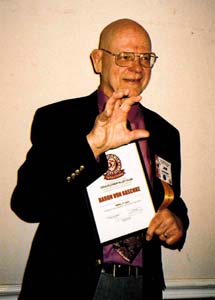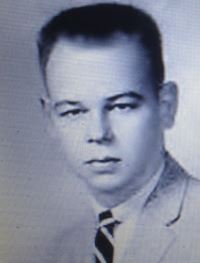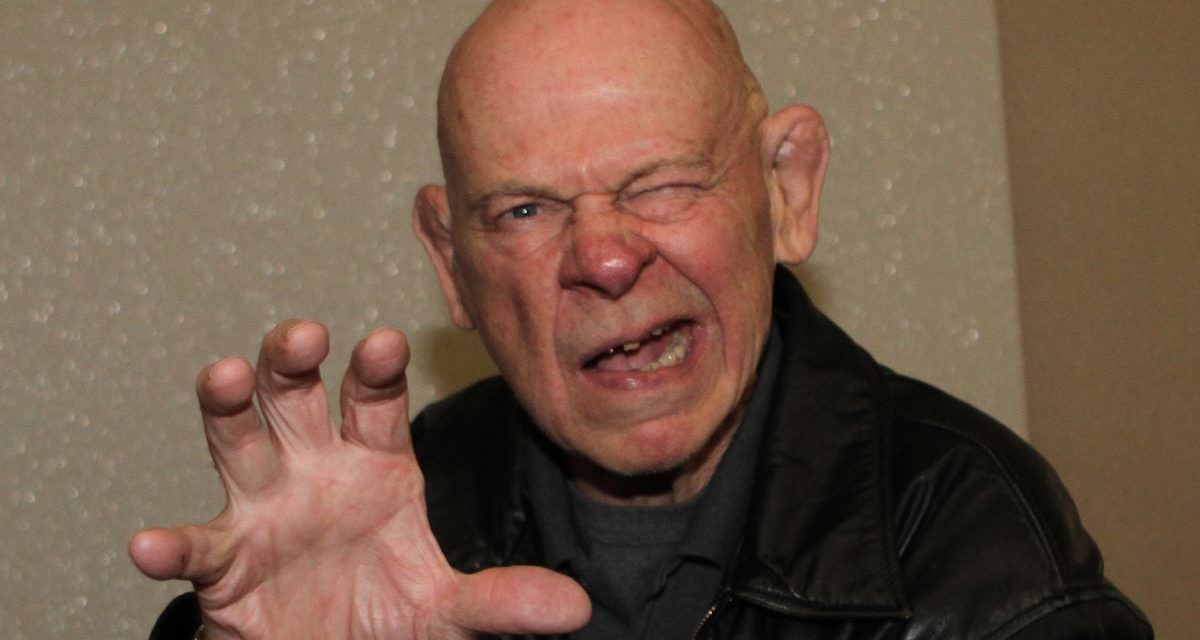Baron von Raschke, with his militaristic goose-step and infamous “brainclaw” submission hold, was one of wrestling’s most nefarious and memorable heels.

The Claw Sculpture.
Though born in Nebraska, he fanned the flames of postwar resentments by portraying a Nazi and left a trail of bloodstained canvases as he enraged audiences in his wake over a decades-long career.
With a shaven head and wearing a crimson-red cape, he snarled in his best German accent: “I am ordered to win” and “Dat is all da people need to know.”
What jeering American audiences didn’t realize was that the Baron had a stellar amateur background and, behind the heel antics, he was a perfect villain to showcase the heroism of all-American babyfaces like Bruno Sammartino and Verne Gagne.
That’s why Baron von Raschke will be presented the prestigious Iron Mike Mazurki Award, the highest honour in the professional wrestling business, at the Cauliflower Alley Club’s 53rd reunion in Las Vegas, April 30-May 2.
SLAM! Wrestling recently caught up with The Baron for an in-depth chat about his introduction to pro wrestling and the early days of “Little Jimmy Raschke from Nebraskey.”
In part one of our interview, Baron von Raschke delves in to his amateur wrestling career, breaking into the business, and the legacy of his dreaded brainclaw.
Stay tuned to SLAM! Wrestling for part two, in which The Baron discusses his friend and tag team partner, Mad Dog Vachon, his managers Freddie Blassie and Bobby Heenan, and his life with “Mrs. Claw.”
SLAM! Wrestling: First off, congratulations on being honoured with the Iron Mike Mazurki Award at the upcoming Cauliflower Alley Club banquet.
BARON VON RASCHKE: Well, it means a lot to me because apparently my peers think I did a good job when I was active in pro wrestling, and that’s always a good thing. And I’m really thrilled and surprised and happy and all those kinds of things.
SLAM! Wrestling: Have you previously been to a Cauliflower Alley Club Reunion?
BARON VON RASCHKE: I’ve only been to a couple Cauliflower Alley Club reunions and always enjoy seeing the guys, because wrestling’s a business where you’re in one area for a while and then you were gone for several years and then you see the guys in another territory or someplace else. So, it’s always fun to get together at the CAC or the George Tragos/Lou Thesz Professional Wrestling Hall of Fame and share the stories and remember the things that you forgot.

Baron von Raschke at a previous Cauliflower Alley Club reunion. Photo by Rose Diamond.
SLAM! Wrestling: Tell us about The Claw Sculpture, a polyresin replica of your infamous brainclaw, which was recently cast.
BARON VON RASCHKE: A guy that runs MEARS Auctions House in Milwaukee had me come in and do an autograph session for a show he had down in a park outside of Chicago. I met him and he was really excited about having a wrestler and his name is Troy Kinunen. We did our business and I got along with him and his wife, and his son “Little” Troy who had been exposed to the claw. So, I had fun with showing him the claw, then he’d scare me with the claw (laughs). Anyways, he was just a little guy. I had my wife Bonnie, “Mrs. Claw,” with me and we got along well and we parted our ways.
Then he called me out of the blue maybe a year later and wanted me for another signing in Milwaukee. They live in an old abandoned church which he turned into a museum, and he started out as a baseball fanatic collector, and he collected baseball bats and has a wall of bats neatly displayed in beautiful cases throughout this huge building. They just lived in part of it and he showed me the museum and he showed me this motorcycle that was awarded to Mickey Mantle for being the most valuable player one year.
He even had a mock-up of one of the robes I’d worn and he had that on display, and some general memorabilia he had collected of me. He had just gotten into wrestling, he wasn’t a lifelong wrestling fan, so I went to work for him again and signed pictures in Milwaukee, and he had a local promoter put on a show and I went and met the fans and he said something about making a cast of the claw and I said, “Oh, that sounds interesting,” so several months later I did another signing thing. In the meantime, he arranged with this artist, (J. Anthony) Kosart, in Chicago who won a Face Off (reality television game show) prize that year so he was quite an artist and knew all about making molds. So, he and three of his co-workers met my wife and I and proceeded to make a cast of the claw.
Making the claw, they wrapped my hand and then I had to sit there for about an hour and a half without moving, and it was supposed to come off really easy but we ended up having to pull my hand out of the mold. I couldn’t use my hand for about six months afterwards because I tore some surrounding tissues and I could barely brush my teeth. So that’s how it came about and it turned out really well.
SLAM! Wrestling: When applying the brainclaw, did you have to adjust to fit the larger heads of opponents like Blackjack Mulligan, Crusher Blackwell, or Andre the Giant?
BARON VON RASCHKE: (Note: he shouted this in his Baron voice, reviving the character for an answer in “kayfabe”) Everything depended on my opponent and I adapted to the situation. That’s what I do. I wrestled Andre the Giant several times and it takes two hands to handle a whopper!
SLAM! Wrestling: And you are ambidextrous, right?
BARON VON RASCHKE: Yes, I use mostly the right hand but sometimes the left. I can be very sneaky.
SLAM! Wrestling: Before the brainclaw became your finisher, you often finished opponents off with a Prussian sleeperhold…
BARON VON RASCHKE: The Prussian sleeper is basically the same as a sleeper hold but it’s a different way of putting on a sleeper, using one of your opponent’s arms. You get him in a different position and then you put pressure on the carotid arteries and with any luck at all they lose consciousness.
SLAM! Wrestling: Tell us about the 11 years you wrestled amateur before turning pro.

Little Jimmy Raschke from Nebraskey.
BARON VON RASCHKE: I started out as an amateur wrestler in high school, I started as a sophomore because I couldn’t dribble or shoot playing basketball like my big brother Ron, so I resorted to going out for amateur wrestling in the winter months. My coach, he said, “Ah, it’s too late, you’ll get your clock cleaned and you’ll never come back.” But I went back the next year, I’m kind of a stubborn guy, and I fell in love with wrestling so I wrestled as an amateur in high school.
Then when I went to the University of Nebraska where I played football and I wrestled, and luckily Olympic champion Bill Smith was a coach at Nebraska during my freshman and sophomore years and I learned a lot from him and that carried me through. I actually won the Big Eight (Conference Heavyweight) title, and then I went into the army and I wrestled for the army for two years and won two National A championships.
Before that I made the World (Games) team and placed third in the world and was the second American ever to place in Greco Roman wrestling, and then I actually made the Olympic team in 1964 but I got hurt and didn’t make the trip to Tokyo. I’m almost over that now, but it lingers.
SLAM! Wrestling: Where did you wrestle when you were in the United States Army?
BARON VON RASCHKE: Any place they had a wrestling match in the country. I had to find out, and when I was in the army I went for basic training and they knew about my wrestling background and asked me if I wanted to continue doing that and I said yes, so they sent me to Fort Lewis in Washington State, and Fort Hamilton in Brooklyn, New York.
For some reason I chose New York because I wrestled there in tournaments a few times during my fifth year in college, and they sent me to Brooklyn and Fort Hamilton and that’s where I was for two years. I worked out with all the wrestlers at the New York AC (Athletic Club). The way it worked was, as a wrestler for the army, every year they would have an all army tournament where they’d gather all the wrestlers from around the world from Alaska, from Germany, or from wherever they were in the army.
We’d gather at the academy at West Point in New York, wrestle in the all-army tournament and we would wrestle for the (Worldwide) Inter service (Wrestling Championships) which was the army, navy, air force and marines in that tournament. And then we could keep wrestling until the AAU (Amateur Athletic Union) championships came up and the Olympic tournaments, so I would just find different places that were having amateur wrestling tournaments through Amateur Wrestling News or whatever it was, and I would be able to make my way there by hitching rides on getting on a plane if I had to, or whatever. I usually found a way to get there and wrestled.
SLAM! Wrestling: Did amateur wrestling ever take you to Canada?
BARON VON RASCHKE: I had never been to Canada. As a matter of fact, the reason I first went to Canada, I was still “Little Jimmy Raschke from Nebraskey” when I broke into pro wrestling. After I had gotten out of the army I had taught school for a year in Omaha, Nebraska, which was part of West Germany at the time (laughs). That’s a joke.
Anyways, while I was in the army I got hurt wrestling and had a knee operation, and the guy next to me — I wasn’t a big pro wrestling fan and hardly had ever seen it except on TV — was John Cunningham, he was a submariner. They put me in a naval hospital for some reason and we woke up next to each other in the hospital. He had the same operation I had the same day I guess, and we did therapy and we just got to be buddies and he loved pro wrestling and dragged me down to the TV room every Saturday and we’d watch the WWWF wrestling shows on TV.
Then I got the silly idea in my head, “Hey maybe this is something I could do?” I didn’t know, but during my idle time in the hospital, they kept us there for over six weeks, and I wrote to the TV station with the name of the promoter. I didn’t know him, but it got to him and I gave him all my amateur qualifications and I’m sure the guys in the locker room had a good laugh if Joe (Dusek) showed them the letter. So, he wrote a nice letter back and said he didn’t have any facility to train anybody but if I contacted him when I got out of the army he would introduce me to Verne Gagne, who was running the AWA with Wally Karbo.
Maybe a year later, I got out of the army and made the world team that year as well, it was ’65. After the world tournament I thought, “Oh, I’m only making so much money a year,” I was making $5,000 teaching and I thought there’s got to be a better way. I contacted Joe Dusek and called him up and he said come down to the TV on such a night and Verne Gagne would be in town that day.
I went down and Joe introduced me to Verne and Verne said, “Well, come up to Minnesota and we’ll see what you’ve got,” so I went up to Minnesota and waited around for two weeks or so to finally see Verne in the office and he told me he would start breaking me in.
Verne had a farm with a ring set up outside and I’d go out there every day and we’d train. I had to lift weights down in his gym in the basement and I jogged and I ran and I chopped wood and did everything to be in good shape. At the time, I was the only one there. Before that he had trained several guys who later did pretty well, so I was very lucky because I was the only student in his class, I guess, and after we trained for a couple of months he and Wally had me take the ring to different towns — all the shows in the area like Minnesota, Wisconsin, the Dakotas. I would drive the little pick-up truck with the ring in the back and set it up an hour before the shows and tear it down afterwards and I’d wrestle the smaller shows. I’d referee four or five matches every night, and that’s how I broke in.
RELATED LINKS

